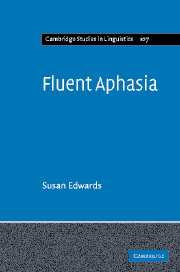Book contents
- Frontmatter
- Contents
- List of figures
- List of tables
- Acknowledgements
- Introduction
- 1 Fluent aphasia: identification and classic descriptions
- 2 Descriptions of fluent aphasia
- 3 Assessment and fluent aphasia
- 4 Connected fluent aphasic speech
- 5 Non-fluent and fluent aphasic speakers. What are the differences?
- 6 Comprehension and processing problems in fluent aphasia
- 7 The manifestation of fluent aphasia in one speaker
- 8 Some concluding thoughts
- References
- Index
5 - Non-fluent and fluent aphasic speakers. What are the differences?
Published online by Cambridge University Press: 22 September 2009
- Frontmatter
- Contents
- List of figures
- List of tables
- Acknowledgements
- Introduction
- 1 Fluent aphasia: identification and classic descriptions
- 2 Descriptions of fluent aphasia
- 3 Assessment and fluent aphasia
- 4 Connected fluent aphasic speech
- 5 Non-fluent and fluent aphasic speakers. What are the differences?
- 6 Comprehension and processing problems in fluent aphasia
- 7 The manifestation of fluent aphasia in one speaker
- 8 Some concluding thoughts
- References
- Index
Summary
Introduction
In this chapter we will review some studies that have highlighted the differences between fluent and non-fluent aphasia. A description of non-fluent aphasia was given in chapter 1, largely based on work of Goodglass and his colleagues. Clinically, fluent and non-fluent aphasias sound different but the boundaries between these two aphasia types are not always clear and not all patients can be clearly identified. Over the past twenty years or so, there have been a large number of studies that have set out to investigate specific aspects of agrammatic speech, some of which have included fluent aphasic subjects as one of the control groups. These studies have been based on the premise that some division of aphasia types is justified and that what is required is a more precise definition of the nature of aphasia, especially aphasia arising from lesions in the anterior areas of the fronto-temporal region. These lesions are typically found in the area known as Broca's area but may extend into adjacent left frontal peri-Sylvian cortex (Ullman, Corkin, Coppola et al. 1997:273). The subjects under scrutiny are variously referred to as Broca's aphasics, non-fluent aphasic or agrammatic subjects. Remember that all agrammatic individuals have Broca's aphasia but researchers do not regard Broca's aphasia as inevitably synonymous with agrammatism. The varied use of these terms is not always justified and the debate about what does and does not qualify as agrammatic is unresolved and tangential to our purposes.
- Type
- Chapter
- Information
- Fluent Aphasia , pp. 122 - 147Publisher: Cambridge University PressPrint publication year: 2005
- 3
- Cited by



